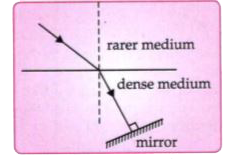When a ray of light travels obliquely from a rarer medium to a denser medium, it bends away from the normal.
without deviation
towards normal
away from normal
parallel to the normal
Step by step video solution for When a ray of light travels obliquely from a rarer medium to a denser medium, it bends away from the normal. by Physics experts to help you in doubts & scoring excellent marks in Class 8 exams.
Updated on:21/07/2023Similar Questions
(a) State Snell's law of refraction of light.
(b) A transparent medium A floats on another transparent medium B. When a ray of light travels obliquely from A into B, the refracted ray bends away from from the normal. Which of these two media A or B are optically denser and why ?
View SolutionA ray of light travelling obliquely from glass to air :
View Solution
Knowledge Check
When a light ray enters from a denser medium to a rarer medium.
AThe light ray bends towards the normal.BAngle of incidence is less than angle of refraction.CSpeed of light decreases.DSpeed of light remains unchanged.When a ray of light from air enters a denser medium, it :
Abends away from the normalBbends towards the normalCgoes undeviatedDis reflected back
When a light ray from a rarer medium is refracted into a denser medium, its
View SolutionWhen a ray of light travels from optically denser medium to optically rarer medium, it always bends towards the normal.
View SolutionAssertion A ray of light travels from first medium to second medium. In first medium, angle of ray with normal is i1=30∘ and in second medium i2 = 60∘ Then, second medium is rarer medium.
View SolutionWhen a ray of light travels from an optically less denser medium to an optically more denser medium, the angle of incidence is always less than angle of refraction.
View SolutionWhen a ray of light travles from an optically more denser medium to an optically less denser medium, the angle of incidence is always _____ than the angle of refraction.
View SolutionA ray of light is moving from a rarer medium to a denser medium and strikes a plane mirror placed at 90∘ to the direction of the ray as shown in the diagram.

Name the principle you have used to mark the arrows to show the direction of the ray.
View Solution
